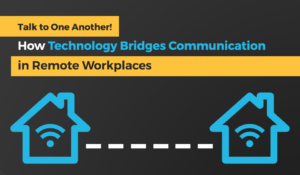 Welcome to the world of telecommuting. Thanks to technological tools, you have the option to let workers have a home office. Remote workers have a benefit of taking on their job duties from the comfort of their own homes rather than trying to make it to the office on time every morning, spending more money on gas for the long drive into work, catching a cold, calling in sick or worrying about whether they can pick up their kids from school at 3 p.m.
Welcome to the world of telecommuting. Thanks to technological tools, you have the option to let workers have a home office. Remote workers have a benefit of taking on their job duties from the comfort of their own homes rather than trying to make it to the office on time every morning, spending more money on gas for the long drive into work, catching a cold, calling in sick or worrying about whether they can pick up their kids from school at 3 p.m.
Telecommuting has plenty of benefits for workers, but it also benefits your business. With fewer people at the office, you spend less money on maintaining a building. When then are less electronic machines at the office, your power consumption costs decrease. Workers are generally happier when they work from home as remote workplaces allow for a better work-life balance thanks to flexible work arrangements. Happier workers, in turn, are more productive and get more stuff done.
Telecommuting isn’t for everyone, but there are many technological tools that drive this relatively new way of working. These tools focus on the need for accurate communication among remote workers and the physical office.
Cloud Computing
The main driver of remote workplaces is cloud computing. Thanks to cloud-based systems, workers can access proprietary software, data and their company’s computer system from their own computers at home. Workers access these technological tools through encrypted passwords and a stable internet connection.
Cloud-based systems allow for more efficient productivity and collaboration anyway, regardless of whether your company has telecommuters. Make sure your cloud computing is robust, has necessary safeguards against data breaches and allows for growth when your telecommuting team expands.
Videoconferencing and Teleconferencing
One of the downsides of telecommuting can be a lack of collaboration. Remove that obstacle by employing teleconferencing and videoconferencing software. You have tons of options on the market today, and because of that there are plenty of low-cost choices. Good teleconferencing software allows people to phone into a set meeting through a website, and these websites have chat and file-sharing capabilities. Videoconferencing software allows for easy connections, multiple people at once and plenty of ways to interact aside from talking to each other.
The key to this communication is that your computer system and your remote workers need to have the same software. You can either download software or use web-based programs. Internet connections must have enough bandwidth to handle high loads of data.
Mobile Devices
Mobile devices continue to gain popularity as productivity tools. More and more companies create apps that let employees communicate on the fly even without a computer. Mobile devices keep remote workers in touch when they are away from home in case they need to access data in the field or when emergencies arise.
The main issue with mobile devices comes from cybersecurity and whether or not to supply mobile devices to employees or allow a BYOD policy. Alleviate your concerns and the concerns of employees with a great password manager and a written mobile device policy.
Conclusion
Telecommuting continues to grow, and you should see more companies go with this business model in the next few years. Make sure your technology keeps up with the times, because remote workers are an important asset to your firm. Flexible work arrangements through telecommuting are one way to offer an extra benefit to top talent seeking a position with your company.
ISOutsource can help you determine your technology needs, whether you have the right capabilities for a remote workforce and how to have the best security practices when it comes to telecommuting employees. Contact us today!
